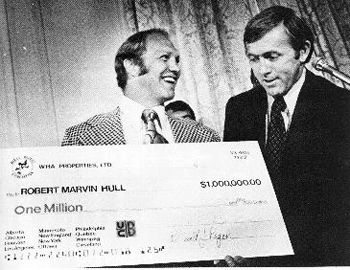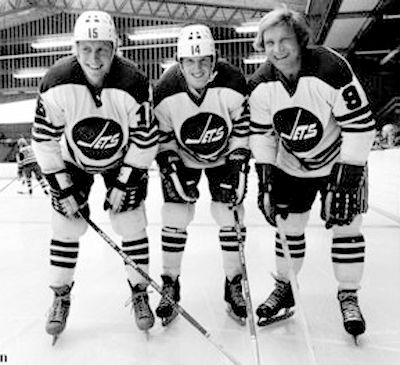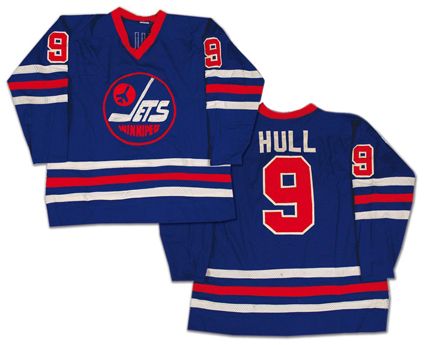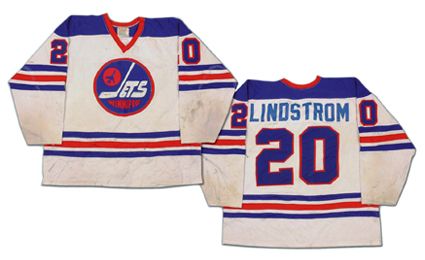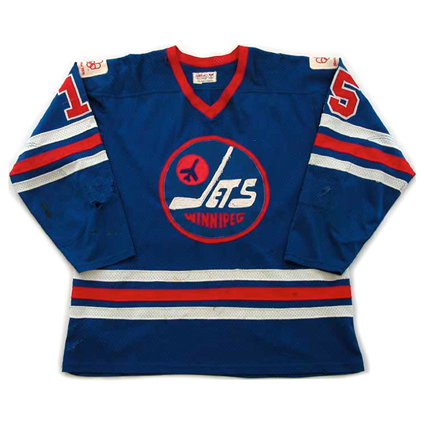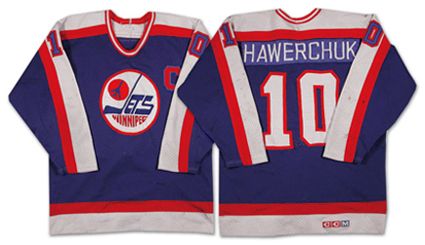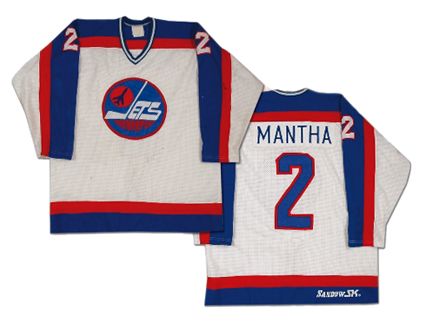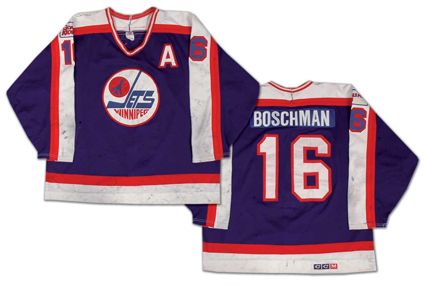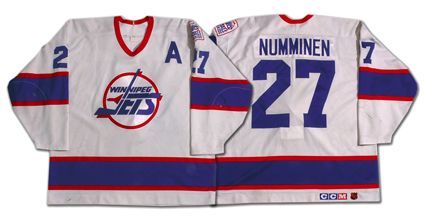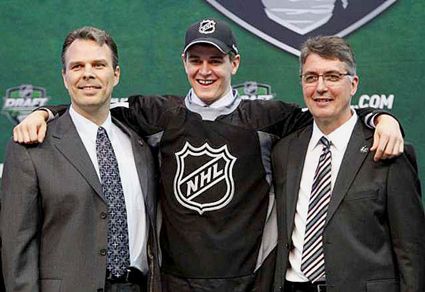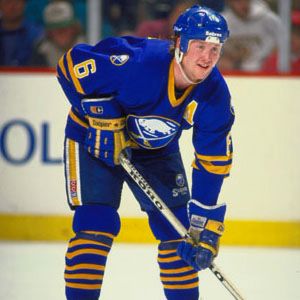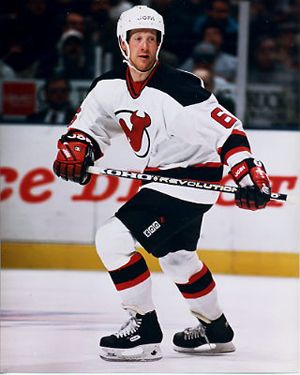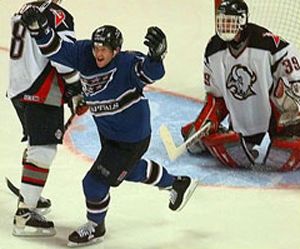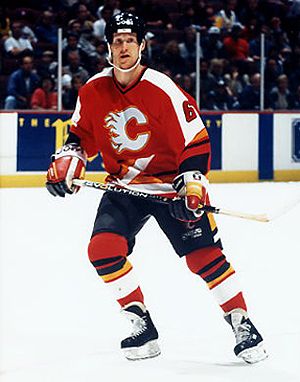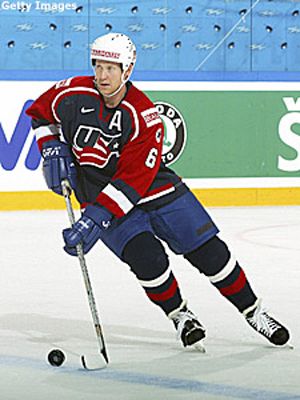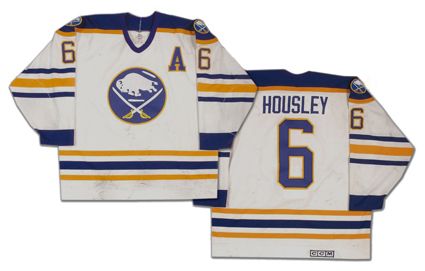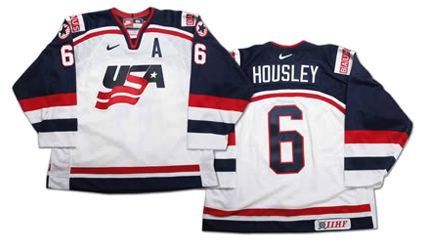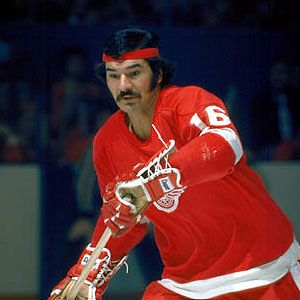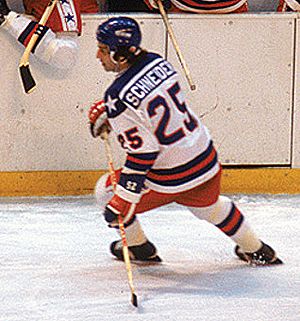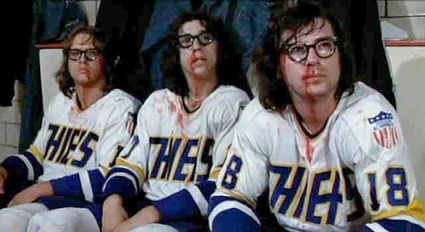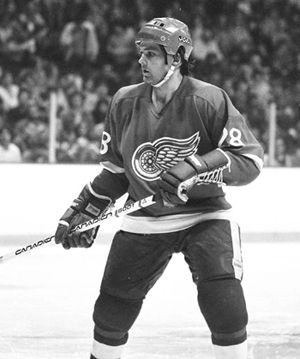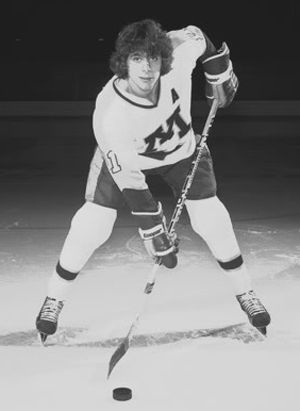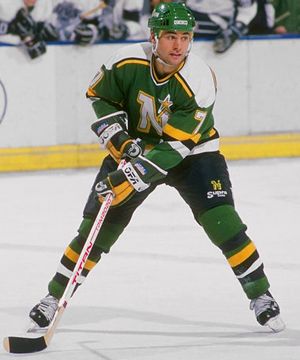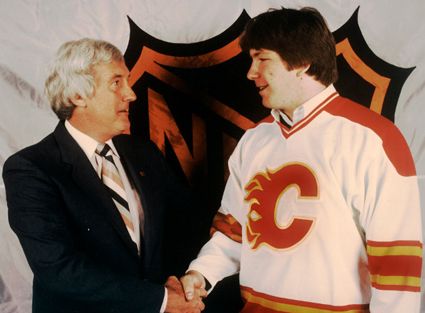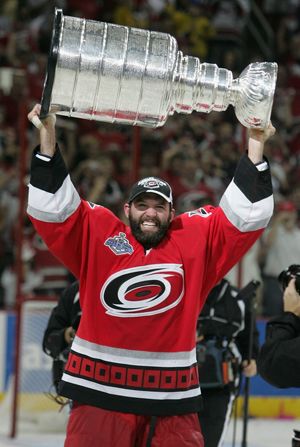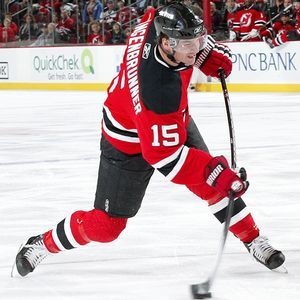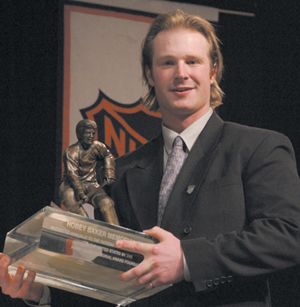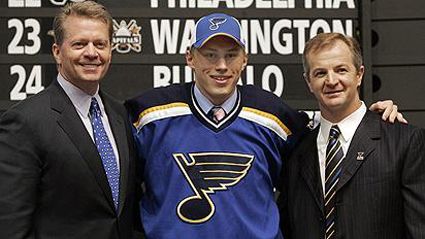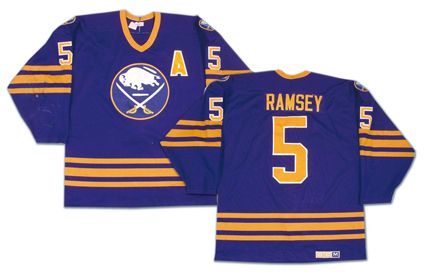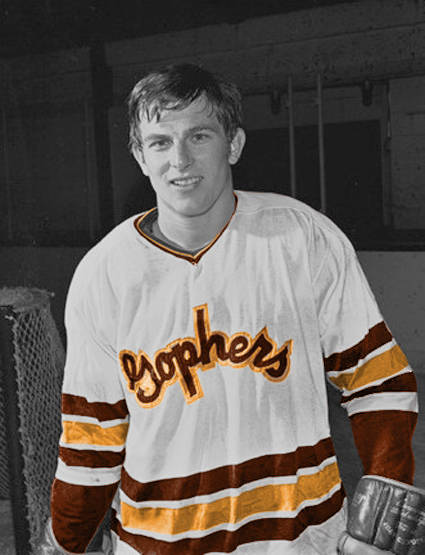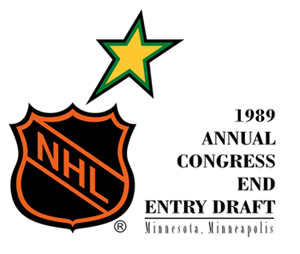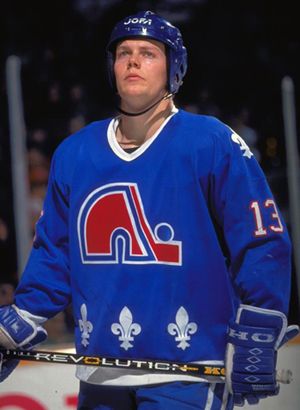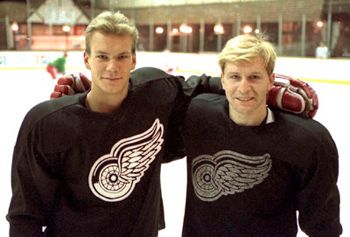Saturday, June 25, 2011
The Jersey History of the Winnipeg Jets 1972-1996
With the seventh pick in the 2011 NHL Draft, the Winnipeg NHL franchise selected...
the name Winnipeg Jets.
We heard speculation ranging from the True North ownership group keeping the Manitoba Moose name and identity intact for their new NHL franchise, to the use of the historic name Winnipeg Falcons, the first team to win an Olympic gold medal for ice hockey back in 1920, or the choice of the brand new name Winnipeg Ice, with a polar bear logo while using a main color of light blue, as well as the rumored return of the classic name Winnipeg Jets, which was the obvious clear fan favorite.
The Winnipeg Jets name dates back to 1967 and a junior franchise which played in the Western Canada Hockey League. With the arrival of the professional WHA franchise, the junior team changed it's name to the Winnipeg Clubs in 1973-74, followed by the Winnipeg Monarchs in 1976-77 for a single season prior to relocating, when they became the Calgary Wranglers for 10 years. After one more move, the club became the Lethbridge Hurricanes in 1987, where they still compete today.
With the formation of the World Hockey Association back in 1972, the new professional franchise adopted the name Jets, and they immediately rocked the hockey world by signing one of the biggest stars of the NHL, Bobby Hull of the Chicago Black Hawks.
The Jets first jerseys were a simple blue sweater with white/red/white stripes around the arms and waist and sported a Jets wordmark on the front created with beautiful chain stitching accented with an overly detailed hockey player inside the J. The most unique aspect of the initial Jets sweaters was the treatment of the chain stitched name on the back. A unique rounded and color-contrasting nameplate carried the player's name in an unusual font, reminiscent of comic sans, which made it appear almost hand written. The white home jerseys also had contrasting nameplates done in an arresting red color.
(This example was prepared for use but never received a red nameplate)
This jersey set would only be used for one season until being replaced by new sweaters for year two which coincided with the arrival of Swedish sensations Anders Hedberg and Ulf Nilsson, who combined with Hull to form the most prolific line of the decade in either the WHA or the NHL.
While the basic jersey striping pattern remained the same, a new round logo filled the front of the jersey, which gave the sweaters a much more clean and modernized look compared those of the previous season.
The Jets would wear patches on each shoulder in 1975-76 in celebration of the Summer Olympics to be held in Montreal, Canada in the summer of 1976. The franchise would also win the Avco World Cup as champions of the WHA for the first time that same season.
While the white jerseys had a blue shoulder yoke since their inception, the blue road jerseys were a solid color until 1977-78, when a white shoulder yoke was added for the first time. The team would also win their second Avco World Trophy at the conclusion of the season and repeated as champions in 1978-79 by winning the final game in the history of the WHA.
The WHA had started out with 12 teams in 1972-73 and grown to a high of 14 teams by 1974-75, the league suffered from instability and frequent franchise relocation, which led to franchises folding with greater frequency as the league shrank to 12, then 10 and finally seven clubs in 1978-79. After the conclusion of the 1978-79 season, four of the six surviving clubs were allowed into the NHL as expansion teams under highly restrictive, nearly crippling, stipulations which affected the Jets more than any other of the four surviving WHA clubs.
While the Hartford Whalers (73 points) and Edmonton Oilers (69 points) qualified for the playoffs during their first season in the NHL in 1979-80, the Quebec Nordiques missed out on the playoffs with 61 points and the Jets tied for last place in the league with the moribund Colorado Rockies with 51 points just one year removed from back-to-back WHA championships.
To celebrate their move to the NHL, the Jets took the opportunity to revamp their jerseys, introducing an entirely new (to them) jerseys which featured full length sleeve striping, a pattern formerly used by the New York Rangers while under the control of general manager John Ferguson, who now held the reins in Winnipeg. One unique feature of the jersey was the extremely thin font used for the names on the back.
This style would serve the Jets well through 11 seasons until 1989-90. In 1981-82 the team would wear a Ten Seasons patch. The 1987-88 season would see the addition of the first Goals for Kids patch on the right arm as well as a thickening of the lettering used for the names on the back, something long overdue for readability. The following year the Goals for Kids patch would be revamped, making the lettering bolder and easier to read.
In 1990-91, the Jets jerseys underwent their final redesign, with bold waist and arm stripes trimmed with thinner red stripes replacing the full length arm stripes. Additionally an attractive new modernized logo was unveiled, creating a new and exciting, yet simple and classic look at the same time, aided in part by the choice of single color names and numbers in an era where only three other of the 20 teams opted for one color numbers, Original 6 clubs Detroit and Toronto as well as Quebec.
The Goals for Kids patch was also modernized at the same time and was worn through the remainder of the club's tenure in Winnipeg. The other patches worn on this style jersey were the NHL 75th Anniversary patch in 1991-92 and the Stanley Cup Centennial patch in 1992-93. Unusually, all the teams wore the patch with a bold white outline, save for the Jets, who during the second half of the season, wore a version of the patch without the white outline after having done so during the first half of the season.
The final season of the Jets in Winnipeg saw them wear the Cherished Memories patch for the final ten games of the regular season and their playoff series against Detroit before the club's sale and relocation to Phoenix for the 1996-97 season.
With the recent announcement that the Atlanta Thrashers had been sold to a group from Winnipeg who would be moving the team to Manitoba, speculation over the name of the club had been talked about since the announcement on May 31st. Finally last night during the first round of the 2011 NHL Draft, team chairman Mark Chipman simply announced that club general manager Kevin Cheveldayoff would make their pick "on behalf of the Winnipeg Jets", sending the many fans who made the trip down to St. Paul from Winnipeg into a loud celebration on the confirmation of the name that everyone wanted to return for over 15 years.
The team did not, however, unveil their team colors, logo or jersey, as first round draft pick Mark Scheifele wore a generic black and silver jersey adorned with the NHL logo when posing for photos with Jets executives on stage.
Time will tell if the new Winnipeg Jets will continue the use of the original Jets red, white and blue colors or claim a new set of colors in an effort to distinguish the new era of hockey in Winnipeg.
Today's video section begins with Teemu Selanne scoring the goal which broke Mike Bossy's 15 year old rookie scoring record in two parts.
Next, last night's announcement of the choice of the name Jets for the relocating franchise and the team's use of the generic black NHL jersey for draft pick Scheifele. The footage of Scheifele's proud mother was one of the highlights of the entire evening.
Labels:
2011 NHL Draft,
Winnipeg Jets
Thursday, June 23, 2011
1988-89 Buffalo Sabres Phil Housley Jersey
The 2011 NHL Entry Draft will be held in St. Paul, Minnesota today. As the final part of our countdown to the draft, we are going to take a look today at the greatest Minnesotan ever selected in the history of the NHL draft.
Phil Housley is one of the rare NHL players who never played a single game in the minors. He was drafted 6th overall in the 1982 NHL Entry Draft out of South St. Paul High School by the Buffalo Sabres.
He was a model of dependability for Buffalo, playing no less than 72 games, scoring a minimum of 15 goals, with a high of 31 in 1983-84, and totaling between 62 and 81 points for each of his eight seasons with the Sabres.
He was sent to the Winnipeg Jets in a deal that saw Dale Hawerchuk go to Buffalo and spent three seasons in Winnipeg cranking out the exact same kind of numbers he had for the Sabres, which included leading the Jets in scoring in both 1990-91 and 1991-92. While he did not lead the Jets in scoring in 1992-93, thanks to the arrival of rookie sensation Teemu Selanne, the high scoring Finn helped Housley to reach a career best 97 points thanks to 18 goals and 79 assists, which ranked seventh in the league and first among defensemen, ahead of even the likes of Paul Coffey.
Housley was then traded to the St. Louis Blues for the 1993-94 season, but was limited to just 26 games in St. Louis before once more being dealt in the offseason, this time to the Calgary Flames. He would play all of the abbreviated 1994-95 season and then 59 games of the 1995-96 season before being shipped to the New Jersey Devils for the final 22 games of the season.
He then signed as a free agent with the Washington Capitals for the 1996-97 season, during which he would play in his 1000th game. His second season with the Capitals would see Housley make his only appearance in the Stanley Cup Finals.
He made a return to Calgary for the next three seasons followed by two as a Chicago Blackhawk who traded him to the Toronto Maple Leafs, his eighth and final team, where he would play in just a single regular season game and three playoff games to end his 21 year career.
Internationally, Housley played for the United States in the 1984 and 1987 Canada Cup tournaments, the World Championships for the United States in 1982, 1986, 1989, 2000, 2001 and 2003 and was a member of the championship winning Team USA at the 1996 World Cup of Hockey.
When Housley retired in 2003, he held the record for most games played by not only a native Minnesotan, but an American, as well as the record for most career points by an American, a feat made even more impressive considering he spent the majority of his career playing defense, although he did skate at forward at times as well. His final statistical totals were 1,495 games played, 338 goals and 894 assists for 1,232 points.
He was inducted into the Buffalo Sabres Hall of Fame in 2007 and the United States Hockey Hall of Fame in 2004.
Today's featured jersey is a 1988-89 Buffalo Sabres Phil Housley jersey. This classic Sabres jersey style would remain in use through the 1995-96 season until replaced by an all new look for Buffalo when the team's colors changed to red, black and white.
It was brought back as an alternate jersey in 2006-07 and was the basis for a new, modernized alternate in 2008-09 before being promoted to the team's primary jersey in 2010-11, much to the delight of the fans.
It was brought back as an alternate jersey in 2006-07 and was the basis for a new, modernized alternate in 2008-09 before being promoted to the team's primary jersey in 2010-11, much to the delight of the fans.
Bonus Jersey: Today's bonus jersey is a 2003 Team USA Phil Housley jersey as worn during Housley's final appearance for the United States National Team and his final competitive hockey before his retirement.
This style USA jersey was introduced for the 2001 World Championships and was used through the 2004 World Cup of Hockey.
This jersey sports Bauhaus sponsor patches on the shoulders, which is a unique element of jerseys worn during the World Championships.
Here is the rock solid Housley absorbing a blow from Sergei Fedorov and quickly skating away while Fedorov is shaken by the collision.
Here Housley plays for the United States in the 1984 Canada Cup versus Dominik Hasek and Czechoslovakia and gets an assist with a blast from the point.
Once more Housley gets an assist with a blast from the point versus Hasek, only this time while playing for the Capitals and wearing the unfamiliar #96.
Labels:
2011 NHL Draft,
Buffalo Sabres,
Housley Phil,
USA
1986-87 Buffalo Sabres Mike Ramsey Jersey
The 2011 NHL Entry Draft, to be held in St. Paul, Minnesota, is just one day away. As part of our countdown to the draft, we are going to take a look today at the Minnesotans selected over the history of the NHL draft.
As we documented earlier, Wally Olds holds the distinction of being the first Minnesotan ever drafted by an NHL team when the Detroit Red Wings chose him in the 5th round 57th overall, just edging out Mike Baumgartner who was chosen by the Chicago Black Hawks just three picks later.
In 1971 Henry Boucha set a new mark as the highest drafted Minnesotan ever when he was chosen in the second round by the Red Wings as the 16th overall selection. Boucha would play six years in the NHL but have his career cut short by a grisly eye injury at the hands of another player in one of hockey's darkest moments. The 1971 draft also set a new mark with six Minnesotans selected, a mark equalled in 1972.
Henry Boucha
When the draft expanded from 13 rounds to a staggering 25 conducted in secret via telephone in 1978 in an effort to prevent the rival WHA from poaching their prospects, the number of Minnesotans rose to 24, with Pete LoPresti taken at #42 being the highest of the group as well as Buzz Schneider who would go onto fame as a member of the 1980 U. S. Olympic Hockey Team.
Buzz Schneider
1975 would see another large group, 21 in all, a group that included 11 year NHL veteran and current Philadelphia Flyers general manager Paul Holmgren as well as both Steve Carlson and Dave Hanson, who would go onto their greatest fame as two of the three Hanson Brothers from the movie Slap Shot.
Dave Hanson and Steve Carlson, along with Jeff Carlson (right) as the notorious Hanson Brothers
The 1976 draft would see more future 1980 Olympians taken, with Bill Baker and Phil Verchota and the state's second ever pick in the second round, defenseman Reed Larson who was taken by the Red Wings.
Reed Larson
Reflecting the strong nature of the program at the University of Minnesota under the guidance of legendary coach Herb Brooks, the 1978 draft saw the first five of the 16 Minnesota players taken all coming off the roster of the Golden Gophers, including 1980 Olympians Steve Christoff, Rob McClanahan and Eric Strobel.
Steve Christoff
While only three Minnesotans were taken in the 1979 draft, the quality of those three players was outstanding, led by the first Minnesotan ever taken in the first round, defenseman Mike Ramsey who was selected at #11 overall by the Buffalo Sabres. The other two players were chosen in the second round, Dave Christian at #40 and Neal Broten, picked #42 by the hometown Minnesota North Stars. Broten would go on to be the first American to ever have a 100 point season in the NHL as well as a Stanley Cup champion. Additionally, the trio would be teammates in Lake Placid as part of the 1980 Olympic Team.
Neal Broten
Phil Housley became the highest drafted Minnesotan when Buffalo chose the defenseman #6 overall in 1982. Housley would make the jump straight from high school to the NHL and set records for American born players for games played at 1,495 and points, with 1,232 during his 21 year career. That year also set a record which still stands when 30 Minnesotans were drafted.
Phil Housley
Tom Chorske became the third player out of Minnesota taken in the first round when he was picked at #16 by the Montreal Canadiens in 1985 and later won a Stanley Cup with the New Jersey Devils in 1995.
Tragedy struck in 1986 when the highest drafted Minnesotan, George Pelawa, taken at #16 of the first round by the Calgary Flames, died in an automobile crash in August of that year. Pelawa had been named "Mr. Hockey" as the top high school player in the state and was about to begin his college hockey career that fall.
George Pelawa after being drafted by Calgary
1988 saw Shjon Podein, Sean Hill and Bret Hedican go onto NHL careers. Doug Zmolek nearly equalled Housely's mark of #6 overall when the Minnesota North Stars picked him at #7 of round one in the only previous draft held in Minnesota in 1989. Trent Klatt was picked at #82 and would see 12 NHL seasons during his career.
Brett Hedican
With NHL teams now able to confidently able to select Soviet players with early round picks in the early 1990's, it woudl take until 1996 for another Minnesotan to be selected in the first round. Until then, the highlight would be Jamie Langenbrunner's selection by the Dallas Stars at #35 overall in round #2.
Jamie Langenbrunner
In 1996, Erik Rassmussen was taken #7 overall in round one by Buffalo. Other notables that year would include Matt Cullen (#35), Mark Parrish (#79) and Dan Hinote (#167).
1999 was David Tanabe's turn to be picked in round one when he was picked at #16 overall and future Hobey Baker Award winner and NCAA champion Jordan Leopold went at #44.
Jordan Leopold poses with the Hobey Baker Award
Jeff Taffe led the Minnesotans taken in 2000 when he went at #30 to the St. Louis Blues before the Devils took two more Minnesotan
s in the second round, Matt DeMarchi at #57 and Paul Martin at #62.
s in the second round, Matt DeMarchi at #57 and Paul Martin at #62.
Defenseman Keith Ballard joined the growing list of first rounders in 2002 when he was picked by the Sabres at #11.
In a first, more than one Minnesota native went in the first round in 2003, led by Zach Parise at #17, followed by Mark Stuart at #21 and Patrick Eaves at #29.
Zach Parise
The Phoenix Coyotes made Blake Wheeler the highest drafted Minnesotan yet when he went at #5 overall in 2004. The Minnesota Wild made it two in the first round with their choice of A. J. Thelen at #12.
Another new record was established in 2005 when four Minnesotans went in the first round, led by Brian Lee at #9 to the Ottawa Senators. Late in the first round T. J. Oshie was picked 24th, Joe Finley 27th and Matt Niskanen 28th.
All of Minnesota's hockey community was proud when Erik Johnson became the first player from Minnesota to ever be selected with the first overall pick in the NHL draft when St. Louis made him the top pick in 2006. The record of four first rounders was equalled when Kyle Okposo was taken at #7 followed by Peter Mueller at #8 and later David Fischer 20th.
Erik Johnson becomes the first Minnesotan selected first overall
Since then Ryan McDonagh (12th), Patrick White (25th) and Jim O'Brien (29th) in 2007, Jake Gardiner (17th) in 2008, Nick Leddy (16th) and Jordan Schroeder (22nd) in 2009 and Derek Forbort (15th), Nick Bjugstad (19th) and Brock Nelson (30th) in 2010 have all been first round selections in the NHL draft.
Brock Nelson skating for Minnesota high school hockey powerhouse Warroad
This year the highest ranked Minnesotans are Seth Ambroz of New Prauge, ranked at the 31st North American Skater, and Mario Lucia of Plymouth, ranked at #34, but perhaps the player with the best chance to be the state's first chosen on Friday is Matt McNeely of Burnsville, who is the 4th ranked of the North American goaltenders. Stay tuned for the 2011 NHL Entry Draft on Versus in the United States and on TSN in Canada, beginning at 7 PM Eastern, 6 PM in Minnesota, to see not only who will be taken first overall, but which player will have the honor of being the first Minnesota native selected in only the second draft ever held in Minnesota.
Today's featured jersey is a 1986-87 Buffalo Sabres Mike Ramsey jersey from the first Minnesotan to ever be drafted in the first round of the NHL draft in 1979.
Ramsey was chosen after one year at the University of Minnesota and next became a member of the 1980 United States Olympic Hockey Team, the youngest member of the gold medal winning squad.
He joined the Sabres immediately after the Olympics and never played a game in the minors. He was a defensive defenseman and played in the NHL All-Star Game four times and was also a member of the NHL All-Stars in Rendez-Vous '87.
He was named captain of the Sabres in 1991-92 and also played for the United States again at the 1984 and 1987 Canada Cups as well as the 1982 World Championships. In 2001 he was inducted into the United States Hockey Hall of Fame following a career which spanned 1,070 games over his 19 year career.
Today's video section features an unexpected find, Mike Ramsey throwing haymakers against Montreal's Mario Tremblay. The two would later be assistant coaches together for the expansion Minnesota Wild!
Here, Neal Broten scores the game winning goal for the Minnesota Gophers in the 1979 NCAA national championship final.
Labels:
2011 NHL Draft
Wednesday, June 22, 2011
1969-70 University of Minnesota Golden Gophers Wally Olds Jersey
With the 2011 NHL Entry Draft, to be held in St. Paul, Minnesota, just two days away our countdown to the draft takes a look today at the first Minnesotan ever selected in the NHL Draft.
Walter "Wally" Olds of Baudette, Minnesota (located on the Canadian border) played collegiate hockey for the University of Minnesota Golden Gophers from 1967-68 to 1970-71. Olds, a defenseman, played in 96 games and scored 21 goals and 36 assists during his three years on the varsity team.
Wally Olds
Following his sophomore season, Olds was selected in the 5th round, 57th overall, by the Detroit Red Wings in the 1969 NHL Amateur Draft, making him the first Minnesotan ever chosen in the seven drafts held up to that point.
Following his career at Minnesota, Olds was a member of the silver medal winning United States Olympic Team at the 1972 games in Sapporo, Japan where Olds and his defensive parter Charlie Brown were not on the ice for an even strength goal the entire tournament.
The silver medalist 1972 United States Olympic hockey team
"He was one of the finest Olympians we ever had," said his Olympic coach Murray Williamson, who coached the 1972 silver-medal U.S. team. "He was a very intelligent gentlemen, very team-oriented and as even-mannered as you could get."
While Olds continued to play hockey, the NHL was not to be, as he never suited up for the Red Wings. At the same time the Olympic hockey tournament was concluding in Japan, Olds was again drafted, only this time by the New York Raiders of the upstart World Hockey Association.
Olds played 20 games for the Long Island Ducks of the Eastern Hockey League in 1972-73 during their final season, as well as the New York Raiders of the WHA for 61 games of their inaugural season.
He stayed in the New York City area the following season as a member of the Long Island Cougars of the North American Hockey League during their first of only two seasons of action. Olds had a good season, scoring 17 goals and 53 points in 67 games.
It was yet another brand new club for Olds in 1974-75, when he moved down the east coast to join the Hampton Gulls debut season in the Southern Hockey League. There, he had by far the finest offensive season of his career when he set personal bests with 19 goals and 61 assists for 80 points to place third on the team in scoring.
He also found time to play in five regular season games with the Oklahoma City Blazers of the Central Hockey League that same year.
The 1975-76 season saw Olds split his time between the Springfield Indians of the American Hockey League, where he played in 35 games, as well as making a return to the WHA with the first year Calgary Cowboys for 28 games.
The following season Olds moved to Europe and joined Kapfenberg of the Austrian league and then competed for the United States at the 1977 World Championships and again in 1979 while competing during the regular season in Germany.
He also played in Switzerland with HC Davos during the 1980-81 season before again playing in the 1981 World Championships, his third and final appearance for the United States.
His also spent time with the Frolunda Indians in Sweden's Elitserien, where in 35 games Olds tallied seven goals and 14 points during the 1981-82 season.
We have found mention of Olds playing in Norway, but no statistical information to verify which seasons, but if listed chronologically, he would have played in Norway following his time in Sweden.
Today's featured jersey is a 1969-70 University of Minnesota Golden Gophers Wally Olds jersey as worn during Olds junior and senior seasons in Minnesota following his selection by Detroit in the 1969 NHL Amateur Draft, making him the first Minnesotan ever selected in the history of the NHL draft.
The 1969-70 season was the first for this style Gophers jersey, which was used for just three seasons prior to being replaced by the first jersey to use the block "M" logo, which remains in use to this day.
Reproductions of this jersey can be purchased from our friends at VintageMinnesotaHockey.com, who generously supplied today's photos of Wally Olds.
Labels:
2011 NHL Draft,
Olds Wally,
University of Minnesota
Tuesday, June 21, 2011
1991-92 Quebec Nordiques Mats Sundin Jersey
The 2011 NHL Entry Draft, to be held in St. Paul, Minnesota, is just three days away. As part of our countdown to the draft, we are going to take a look today at the first, and only, NHL draft ever held in Minnesota.
The 1989 NHL Entry Draft was held at the Met Center in Bloomington, Minnesota, which was home to the Minnesota North Stars. The first NHL draft, then called the Amateur Draft, was held in Montreal, Quebec at the Queen Elizabeth Hotel. Montreal remained host to the draft through 1984, although at a few different venues over time, until Toronto hosted the draft in 1985. It was back to Montreal in 1986, followed by Detroit in 1987, a return to Montreal in 1988 and finally to Minnesota in 1989, only the third time in the draft's 27 year history it was held outside of Montreal.
History was made at the draft when the Quebec Nordiques selected Swede Mats Sundin first overall, making him the first European-born player taken with the first pick in NHL history. He would go on to have a successful 18 year NHL career, scoring 564 goals and 1,349 points in 1,346 games played, putting him among the top 20 all-time goal scorers in league history and the only Swede to reach 500 goals and the first Swede to reach 1,000 points.
Slightly less successful with the second pick, the New York Islanders selected Canadian Dave Chyzowski who played just 126 NHL games while scoring 15 goals. He would go on to have an 18 year career, but the majority of it was spent in the IHL and in Europe.
Scott Thornton was picked third by the Toronto Maple Leafs and had a long NHL career which lasted until 2008.
The Winnipeg Jets took Stu Barnes fourth followed by the New Jersey Devils choice of Bill Guerin. The host Minnesota North Stars picked Minnesota native Doug Zmolek 7th overall, but he would end up as property of the San Jose Sharks and would never wear the North Stars sweater.
Other notables in the first round were Bobby Holik at #10 to the Hartford Whalers and the well-travelled and Third String Goalie favorite Mike Sillinger to the Detroit Red Wings at #11. Olaf Kolzig was the first goaltender taken 19th by the Washington Capitals and would go on to serve the Capitals for 16 seasons.
Round 2 saw the Nordiques make another solid pick when they chose Adam Foote, who would play for the franchise for 13 years in his first tour of duty with the team, including a pair of Stanley Cups following the Nordiques relocation to Colorado.
The Capitals again chose a goaltender in the second round when they chose Byron Dafoe with the 35th pick.
The Detroit Red Wings then began to distance themselves from the herd with their third round selection of defenseman Niklas Lidstrom, who will play his 20th season in Detroit in 2011-12 and is widely regarded as one of the best defenseman in the history of the league.
The other main notable of the third round was Kris Draper, taken #62 by Winnipeg, but later acquired by Detroit for a single dollar in 1993. He would prove to be one of the greatest bargains in league history by going on to play 17 seasons with Detroit, contributing to four Stanley Cups and winning a Selke Trophy in the process.
The highlight of round four again went to the Red Wings, with their pick of Sergei Fedorov of the Soviet Union. Following his defection from the Soviet Union, his flashy style would make him a star player of the 1990's, which included a 56 goal season in 1993-94. His trophy cabinet would include the Hart, Pearson and Selke Trophies in 1994, another Selke in 1996 and three Stanley Cups, all with Detroit.
Another club to risk a later pick on a Soviet was the Vancouver Canucks, whose choice of Pavel Bure at #113 paid off handsomely when Bure became an NHL star with seasons of 60, 60, 51, 58 and 59 goals during his 12 year NHL career.
Also of note were steals Donald Audette at #183 in round nine by the Buffalo Sabres, goaltender Arturs Irbe at #196 by Minnesota in round ten and another addition to the embarrassment of riches for Detroit with their selection of rugged defenseman Vladimir Konstantinov of the Soviet Union with the 221st pick in round #12.
Nicklas Lidstrom and Vladimir Konstantinov were both selected in the 1989 draft
In all, 252 players were taken over the 12 rounds of the draft from Sweden, Canada, the United States, Czechoslovakia, West Germany, Finland and the Soviet Union as well as 18 Minnesota natives, led by Zmolek.
Of the players drafted, Lidstrom has played the most games at 1,494 and counting, Sundin the most goals at 564 and points with 1,349.
On the other end of the scale, of the 252 players chosen, 139 would never see action in an NHL game, even seven of the Red Wings picks, despite the amazing success they had that year with their other selections. Another 20 picks would play less than 20 NHL games, 14 of those in the single digits.
This Friday evening the draft returns to Minnesota for only the second time ever with the host Minnesota Wild picking 10th in the first round. Rounds two through seven will take place on Saturday.
Today's featured jersey is a 1991-92 Quebec Nordiques Mats Sundin jersey, the first player taken in the only previous draft held in Minnesota and the first European-born player ever taken first overall.
This jersey features the NHL 75th Anniversary patch worn by all players in the NHL to commemorate the league's anniversary.
This was the first season that the Nordiques added the red trim around their previously single color numbers.
Today's video highlight are the Quebec Nordiques selecting Mats Sundin first overall in the 1989 NHL Entry Draft, the first European ever drafted first overall. Unfortunately for Sundin, they apparently didn't have baseball caps in Sweden at that time, resulting in the world's first stovepipe ballcap.
Labels:
2011 NHL Draft,
Quebec Nordiques,
Sundin
Subscribe to:
Comments (Atom)

